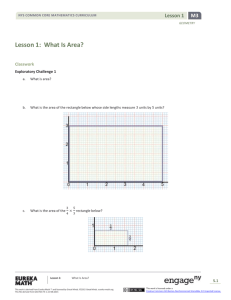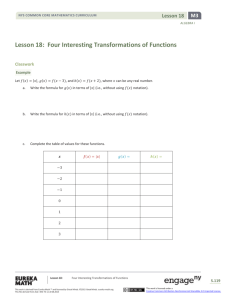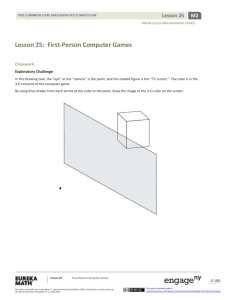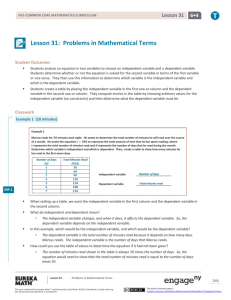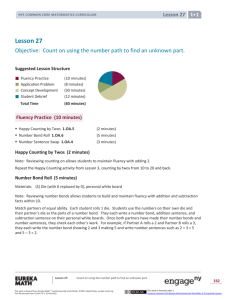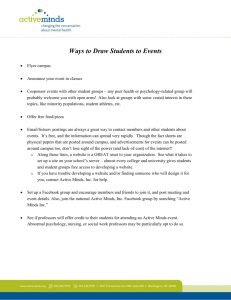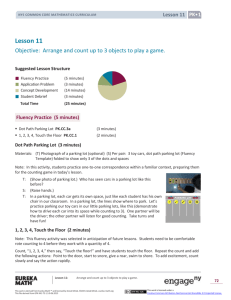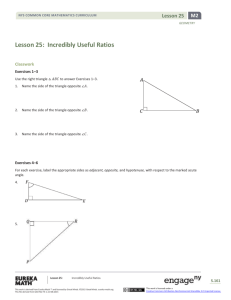Lesson 12 - EngageNY
advertisement
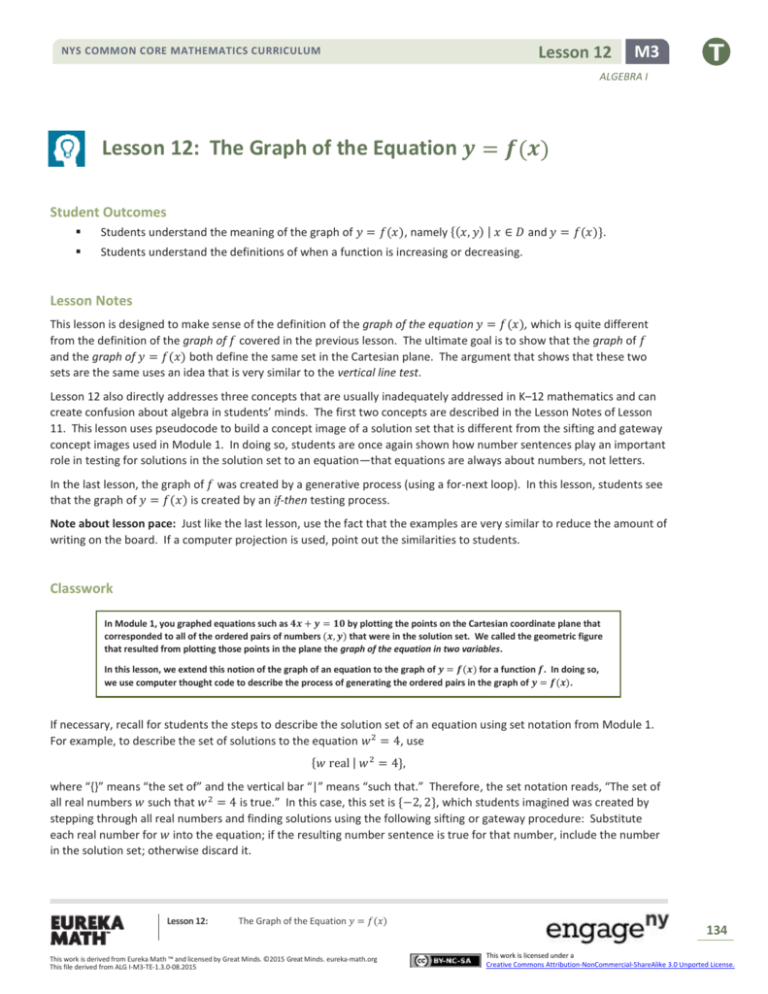
Lesson 12
NYS COMMON CORE MATHEMATICS CURRICULUM
M3
ALGEBRA I
Lesson 12: The Graph of the Equation 𝒚 = 𝒇(𝒙)
Student Outcomes
Students understand the meaning of the graph of 𝑦 = 𝑓(𝑥), namely {(𝑥, 𝑦) | 𝑥 ∈ 𝐷 and 𝑦 = 𝑓(𝑥)}.
Students understand the definitions of when a function is increasing or decreasing.
Lesson Notes
This lesson is designed to make sense of the definition of the graph of the equation 𝑦 = 𝑓(𝑥), which is quite different
from the definition of the graph of 𝑓 covered in the previous lesson. The ultimate goal is to show that the graph of 𝑓
and the graph of 𝑦 = 𝑓(𝑥) both define the same set in the Cartesian plane. The argument that shows that these two
sets are the same uses an idea that is very similar to the vertical line test.
Lesson 12 also directly addresses three concepts that are usually inadequately addressed in K–12 mathematics and can
create confusion about algebra in students’ minds. The first two concepts are described in the Lesson Notes of Lesson
11. This lesson uses pseudocode to build a concept image of a solution set that is different from the sifting and gateway
concept images used in Module 1. In doing so, students are once again shown how number sentences play an important
role in testing for solutions in the solution set to an equation—that equations are always about numbers, not letters.
In the last lesson, the graph of 𝑓 was created by a generative process (using a for-next loop). In this lesson, students see
that the graph of 𝑦 = 𝑓(𝑥) is created by an if-then testing process.
Note about lesson pace: Just like the last lesson, use the fact that the examples are very similar to reduce the amount of
writing on the board. If a computer projection is used, point out the similarities to students.
Classwork
In Module 1, you graphed equations such as 𝟒𝒙 + 𝒚 = 𝟏𝟎 by plotting the points on the Cartesian coordinate plane that
corresponded to all of the ordered pairs of numbers (𝒙, 𝒚) that were in the solution set. We called the geometric figure
that resulted from plotting those points in the plane the graph of the equation in two variables.
In this lesson, we extend this notion of the graph of an equation to the graph of 𝒚 = 𝒇(𝒙) for a function 𝒇. In doing so,
we use computer thought code to describe the process of generating the ordered pairs in the graph of 𝒚 = 𝒇(𝒙).
If necessary, recall for students the steps to describe the solution set of an equation using set notation from Module 1.
For example, to describe the set of solutions to the equation 𝑤 2 = 4, use
{𝑤 real | 𝑤 2 = 4},
where “{}” means “the set of” and the vertical bar “|” means “such that.” Therefore, the set notation reads, “The set of
all real numbers 𝑤 such that 𝑤 2 = 4 is true.” In this case, this set is {−2, 2}, which students imagined was created by
stepping through all real numbers and finding solutions using the following sifting or gateway procedure: Substitute
each real number for 𝑤 into the equation; if the resulting number sentence is true for that number, include the number
in the solution set; otherwise discard it.
Lesson 12:
The Graph of the Equation 𝑦 = 𝑓(𝑥)
This work is derived from Eureka Math ™ and licensed by Great Minds. ©2015 Great Minds. eureka-math.org
This file derived from ALG I-M3-TE-1.3.0-08.2015
134
This work is licensed under a
Creative Commons Attribution-NonCommercial-ShareAlike 3.0 Unported License.
Lesson 12
NYS COMMON CORE MATHEMATICS CURRICULUM
M3
ALGEBRA I
Example 1 (4 minutes)
Example 1
In the previous lesson, we studied a simple type of instruction that computers perform called a for-next loop. Another
simple type of instruction is an if-then statement. Below is example code of a program that tests for and prints “True”
when 𝒙 + 𝟐 = 𝟒; otherwise it prints “False.”
Declare 𝒙 integer
For all 𝒙 from 𝟏 to 𝟒
If 𝒙 + 𝟐 = 𝟒 then
Print True
else
Print False
End if
Next 𝒙
The output of this program code is
False
True
False
False
Ask students to interpret the output: Can they describe how to relate it back to the code? Then go through the code
step-by-step with students as if the class were a computer.
Notice that the if-then statement in the code above is really just testing whether each number in the loop is in the
solution set.
Example 2 (4 minutes)
Before going through the code step-by-step with students as if the class were a computer, ask students to translate the
code into English. For example, ask what the effect the declaration of 𝑥 as an integer has on the for statement. (It limits
𝑥 to the numbers 0, 1, 2, 3, 4.)
In general, is it possible that the set 𝐺 could be empty after the for-next loop?
Yes
Example 2
Perform the instructions in the following programming code as if you were a computer and your paper were the
computer screen.
Declare 𝒙 integer
Initialize 𝑮 as {}
For all 𝒙 from 𝟎 to 𝟒
If 𝒙𝟐 − 𝟒𝒙 + 𝟓 = 𝟐 then
Append 𝒙 to 𝑮
else
Do NOT append 𝒙 to 𝑮
End if
Next 𝒙
Print 𝑮
Output: {𝟏, 𝟑}
Lesson 12:
The Graph of the Equation 𝑦 = 𝑓(𝑥)
This work is derived from Eureka Math ™ and licensed by Great Minds. ©2015 Great Minds. eureka-math.org
This file derived from ALG I-M3-TE-1.3.0-08.2015
135
This work is licensed under a
Creative Commons Attribution-NonCommercial-ShareAlike 3.0 Unported License.
Lesson 12
NYS COMMON CORE MATHEMATICS CURRICULUM
M3
ALGEBRA I
Discussion (2 minutes)
Discussion
Compare the for-next/if-then code above to the following set-builder notation we used to describe solution sets in
Module 1:
{𝒙 𝐢𝐧𝐭𝐞𝐠𝐞𝐫 | 𝟎 ≤ 𝒙 ≤ 𝟒 𝐚𝐧𝐝 𝒙𝟐 − 𝟒𝒙 + 𝟓 = 𝟐}.
Check to see that the set-builder notation also generates the set {𝟏, 𝟑}. Whenever you see set-builder notation to
describe a set, a powerful way to interpret that notation is to think of the set as being generated by a program like the
for-next or if-then code above.
Point out all of the similarities between the set-builder notation and the pseudocode above. For example, where is the
variable specified as an integer in both? During each step of the loop, 𝑥 is an actual number (0, then 1, then 2, …);
hence, it is possible to determine whether the equation 𝑥 2 − 4𝑥 + 5 = 2 is true or false. Similarly, what does it mean
for 0 ≤ 𝑥 ≤ 4 and 𝑥 2 − 4𝑥 + 5 = 2 to both be true? (Students replace “𝑥 integer” later in the lesson with (𝑥, 𝑦),
replace “0 ≤ 𝑥 ≤ 4” with 𝑥 ∈ 𝐷, and “𝑥 2 − 4𝑥 + 5 = 2” with 𝑦 = 𝑓(𝑥).)
Exploratory Challenge 1 (10 minutes)
Exploratory Challenge 1
Next we write code that generates a graph of a two-variable equation 𝒚 = 𝒙(𝒙 − 𝟐)(𝒙 + 𝟐) for 𝒙 in {−𝟐, −𝟏, 𝟎, 𝟏, 𝟐} and
𝒚 in {−𝟑, 𝟎, 𝟑}. The solution set of this equation is generated by testing each ordered pair (𝒙, 𝒚) in the set,
{(−𝟐, −𝟑), (−𝟐, 𝟎), (−𝟐, 𝟑), (−𝟏, −𝟑), (−𝟏, 𝟎), (−𝟏, 𝟑), … , (𝟐, −𝟑), (𝟐, 𝟎), (𝟐, 𝟑)},
to see if it is a solution to the equation 𝒚 = 𝒙(𝒙 − 𝟐)(𝒙 + 𝟐). Then the graph is just the plot of solutions in the Cartesian
plane. We can instruct a computer to find these points and plot them using the following program.
Declare 𝒙 and 𝒚 integers
Initialize 𝑮 as {}
For all 𝒙 in {−𝟐, −𝟏, 𝟎, 𝟏, 𝟐}
For all 𝒚 in {−𝟑, 𝟎, 𝟑}
If 𝒚 = 𝒙(𝒙 − 𝟐)(𝒙 + 𝟐) then
Append (𝒙, 𝒚) to 𝑮
else
Do NOT append (𝒙, 𝒚) to 𝑮
End if
Next 𝒚
Next 𝒙
Print 𝑮
Plot 𝑮
a.
Loops through each 𝒚 for
𝒙 = −𝟐, then for 𝒙 = −𝟏,
and so on (see arrows in
table below).
Tests whether (𝒙, 𝒚)
is a solution.
Use the table below to record the decisions a computer would make when following the program instructions
above. Fill in each cell with “Yes” or “No” depending on whether the ordered pair (𝒙, 𝒚) would be appended
or not. (The step where 𝒙 = −𝟐 has been done for you.)
𝒙 = −𝟐
𝒙 = −𝟏
𝒙=𝟎
𝒙=𝟏
𝒙=𝟐
𝒚=𝟑
No
Yes
No
No
No
𝒚=𝟎
Yes
No
Yes
No
Yes
𝒚 = −𝟑
No
No
No
Yes
No
Lesson 12:
The Graph of the Equation 𝑦 = 𝑓(𝑥)
This work is derived from Eureka Math ™ and licensed by Great Minds. ©2015 Great Minds. eureka-math.org
This file derived from ALG I-M3-TE-1.3.0-08.2015
136
This work is licensed under a
Creative Commons Attribution-NonCommercial-ShareAlike 3.0 Unported License.
Lesson 12
NYS COMMON CORE MATHEMATICS CURRICULUM
M3
ALGEBRA I
Help students understand the nested for-next loop: First, 𝑥 = −2 is kept fixed while 𝑦 loops through −3, 0, and 3. The
Next 𝑥 command then fixes 𝑥 = −1 while 𝑦 again steps through −3, 0, and 3. This continues until 𝑥 = 2 and 𝑦 = 3.
Arrows are drawn on the table to indicate the order of this process.
b.
c.
What would be the output to the Print 𝑮 command? (The first ordered pair is listed for you.)
Output:
{ (−𝟐, 𝟎)
, __________, __________, __________, __________ }
{ (−𝟐, 𝟎),
(−𝟏, 𝟑),
(𝟎, 𝟎),
(𝟏, −𝟑),
(𝟐, 𝟎)}
Plot the solution set 𝑮 in the Cartesian plane. (The first ordered pair in 𝑮 has been plotted for you.)
Solution:
Point out that the “Yes” answers in the table show a similar pattern as the students’ graphs. The point is that this code
checks every ordered pair in the domain and range and appends only those to the set 𝐺 that solve the equation. In the
next exercise, students see that this is the same as set-builder notation.
Exploratory Challenge 2 (15 minutes)
Exploratory Challenge 2
The program code in Exercise 3 is a way to imagine how set-builder notation generates solution sets and figures in the
plane. Given a function 𝒇(𝒙) = 𝒙(𝒙 − 𝟐)(𝒙 − 𝟑) with domain and range all real numbers, a slight modification of the
program code above can be used to generate the graph of the equation 𝒚 = 𝒇(𝒙):
{(𝒙, 𝒚) | 𝒙 𝐫𝐞𝐚𝐥 𝐚𝐧𝐝 𝒚 = 𝒇(𝒙)}.
Even though the code below cannot be run on a computer, students can run the following thought code in their minds.
Lesson 12:
The Graph of the Equation 𝑦 = 𝑓(𝑥)
This work is derived from Eureka Math ™ and licensed by Great Minds. ©2015 Great Minds. eureka-math.org
This file derived from ALG I-M3-TE-1.3.0-08.2015
137
This work is licensed under a
Creative Commons Attribution-NonCommercial-ShareAlike 3.0 Unported License.
Lesson 12
NYS COMMON CORE MATHEMATICS CURRICULUM
M3
ALGEBRA I
Declare 𝒙 and 𝒚 real
Let 𝒇(𝒙) = 𝒙(𝒙 − 𝟐)(𝒙 + 𝟐)
Initialize 𝑮 as {}
For all 𝒙 in the real numbers
For all 𝒚 in the real numbers
If 𝒚 = 𝒇(𝒙) then
Append (𝒙, 𝒚) to 𝑮
else
Do NOT append (𝒙, 𝒚) to 𝑮
End if
Next 𝒚
Next 𝒙
Plot 𝑮
Tests whether (𝒙, 𝒚)
is a solution to
𝒚 = 𝒙(𝒙 − 𝟐)(𝒙 + 𝟐).
For each 𝒙-value, the code
loops through all 𝒚-values.
NESTED FOR-NEXT LOOPS: Code like this is often called a nested for-next loop because the For all 𝑦 … Next 𝑦 loop runs
through all numbers 𝑦 each time a new 𝑥 value is chosen. One can imagine the outer For all 𝑥 … Next 𝑥 loop as stepping
through all numbers 𝑥 from −∞ to +∞ on the 𝑥-axis, and for each choice of a number 𝑥, one imagines the For all 𝑦 …
Next 𝑦 code as stepping through each number 𝑦 from −∞ to +∞ on the vertical number line that passes through the
point (𝑥, 0). The picture below shows an example of this process (for a different function than in the example) at the
step in the thought code where 𝑥 is 4:
In this way the thought code above checks every single point (𝑥, 𝑦) in the Cartesian coordinate plane to see if it is a
solution to the equation 𝑦 = 𝑓(𝑥).
Lesson 12:
The Graph of the Equation 𝑦 = 𝑓(𝑥)
This work is derived from Eureka Math ™ and licensed by Great Minds. ©2015 Great Minds. eureka-math.org
This file derived from ALG I-M3-TE-1.3.0-08.2015
138
This work is licensed under a
Creative Commons Attribution-NonCommercial-ShareAlike 3.0 Unported License.
Lesson 12
NYS COMMON CORE MATHEMATICS CURRICULUM
M3
ALGEBRA I
a.
Plot 𝑮 on the Cartesian plane (the figure drawn is called the graph of 𝒚 = 𝒇(𝒙)).
Solution:
Walk around, and help students construct the graph in groups of two or individually by generating a table of order pairs,
plotting those points, and then connecting the dots between the points with a smooth curve. Remind students that they
can use their work from Exercise 1 to get started. Note that while they do not have to generate the table in the same
way that the thought code builds the set 𝐺, once students have generated a table, ask them what order the thought
code would have found the points in their table.
b.
Describe how the thought code is similar to the set-builder notation {(𝒙, 𝒚) | 𝒙 𝐫𝐞𝐚𝐥 𝐚𝐧𝐝 𝒚 = 𝒇(𝒙)}.
Answer: Both generate sets by checking every point (𝒙, 𝒚) in the Cartesian plane, searching for points (𝒙, 𝒚)
for which the equation 𝒚 = 𝒙(𝒙 − 𝟐)(𝒙 + 𝟐) is true.
Go over this answer with students. Ask for the following:
Domain of 𝑓: all real numbers.
Range of 𝑓: all real numbers.
The thought code describes a systematic way of imagining how all of the points in the graph of 𝑦 = 𝑓(𝑥) are found.
However, the set {(𝑥, 𝑦) | 𝑥 real and 𝑦 = 𝑓(𝑥)} should be thought of as the end result of the thought code; that is, the
set contains all the points of the graph of 𝑦 = 𝑓(𝑥). In this way, students can think of the set
{(𝑥, 𝑦) | 𝑥 real and 𝑦 = 𝑓(𝑥)}
as the actual figure in the plane. (Students have already been introduced to this type of thinking in Grade 8 using the
simple example of associating a line as a geometric figure to the graph of a solution set of a linear equation. They need
this type of thinking in later grades to describe parabolas as graphs of quadratic functions.)
Lesson 12:
The Graph of the Equation 𝑦 = 𝑓(𝑥)
This work is derived from Eureka Math ™ and licensed by Great Minds. ©2015 Great Minds. eureka-math.org
This file derived from ALG I-M3-TE-1.3.0-08.2015
139
This work is licensed under a
Creative Commons Attribution-NonCommercial-ShareAlike 3.0 Unported License.
Lesson 12
NYS COMMON CORE MATHEMATICS CURRICULUM
M3
ALGEBRA I
IMPORTANT: Why are the graph of 𝒇 and the graph of 𝒚 = 𝒇(𝒙) the same set? Note that the graph of 𝑓 was
generated in Lesson 11 using different thought code than the code used to generate the graph of 𝑦 = 𝑓(𝑥). Why do
they generate the same set then? Here’s why: For any given 𝑥, the thought code for the graph of 𝑦 = 𝑓(𝑥) ranges over
all 𝑦-values, which can be thought of as drawing a vertical line that passes through the point (𝑥, 0)—see the picture of
the vertical line at (4,0) in the nested for-next loop discussion above. Because the definition of a function implies that
each number 𝑥 in the domain is matched to one and only one value, 𝑓(𝑥), in the range, there can only be one point on
that vertical line that satisfies the equation 𝑦 = 𝑓(𝑥), namely the point (𝑥, 𝑓(𝑥)) generated by the thought code for the
graph of 𝑓. Since the graph of 𝑓 and the graph of the equation 𝑦 = 𝑓(𝑥) are both restricted to just the 𝑥-values in the
domain of 𝑓, the two sets must be the same.
In the discussion above, the graph of 𝑓 intersects that vertical line through (𝑥, 0) in exactly one point, (𝑥, 𝑓(𝑥)), for 𝑥 in
the domain of 𝑓. This fact shows that the graph of any function satisfies the vertical line test. Do not introduce the
vertical line test now. However, describe how the thought code for the graph of 𝑦 = 𝑓(𝑥) checks each point on the
vertical line for a solution, and why, because of the definition of function, the code finds only one solution on that line
for each 𝑥 in the domain of 𝑓.
Note to teacher: Parts (c) and (d) of the exercise offer an excellent opportunity to check on students’ Grade 8 skills with
square roots (8.EE.A.2). However, if students need an easier problem so that they can scaffold up to parts (c) and (d),
ask students to answer parts (c)–(f) first using the function given by 𝑓(𝑥) = −(𝑥 − 3)2 + 4.
c.
A relative maximum for the function 𝒇 occurs at the 𝒙-coordinate of (−
𝟐
𝟏𝟔
Substitute this point
𝟑 √𝟑, 𝟗 √𝟑).
into the equation 𝒚 = 𝒙(𝒙𝟐 − 𝟒) to check that it is a solution to 𝒚 = 𝒇(𝒙), and then plot the point on your
graph.
Check that
𝟏𝟔
𝟗
𝟐
𝟐
𝟐
√𝟑 = − 𝟑 √𝟑 ((− 𝟑 √𝟑)
− 𝟒) is a true number sentence.
Divide both sides by √𝟑, multiply both sides by
Distributing the −𝟑 shows that (−
𝟗
𝟐
𝟒
𝟑
, and evaluate the square to get 𝟖 = −𝟑 ( − 𝟒).
𝟐
𝟏𝟔
is a solution.
𝟑 √𝟑, 𝟗 √𝟑)
𝟐
𝟏𝟔
(− √𝟑,
√𝟑)
𝟑
𝟗
Lesson 12:
The Graph of the Equation 𝑦 = 𝑓(𝑥)
This work is derived from Eureka Math ™ and licensed by Great Minds. ©2015 Great Minds. eureka-math.org
This file derived from ALG I-M3-TE-1.3.0-08.2015
140
This work is licensed under a
Creative Commons Attribution-NonCommercial-ShareAlike 3.0 Unported License.
Lesson 12
NYS COMMON CORE MATHEMATICS CURRICULUM
M3
ALGEBRA I
Remind students that 𝑥(𝑥 − 2)(𝑥 + 2) = 𝑥(𝑥 2 − 4). If time permits, allow them to use their calculators to see that the
2
16
point (− √3,
√3) really is the point they plotted on their graph.
3
9
d.
𝟐
𝟏𝟔
A relative minimum for the function 𝒇 occurs at the 𝒙-coordinate of ( √𝟑, −
A similar calculation
𝟑
𝟗 √𝟑).
as you did above shows that this point is also a solution to 𝒚 = 𝒇(𝒙). Plot this point on your graph.
𝟐
𝟏𝟔
Students should plot the point ( √𝟑, − √𝟑) on their graphs approximately at (𝟏. 𝟏𝟓, −𝟑. 𝟎𝟖).
𝟑
𝟗
e.
Look at your graph. On what interval(s) is the function 𝒇 decreasing?
𝟐
𝟐
− √𝟑 ≤ 𝒙 ≤ √𝟑
𝟑
𝟑
f.
or
𝟐
𝟐
[− √𝟑, √𝟑]
𝟑
𝟑
Look at your graph. On what interval(s) is the function 𝒇 increasing?
𝟐
𝒙 ≤ − √𝟑 or
𝟑
𝟐
𝟑
𝟐
𝟐
√𝟑 ≤ 𝒙 or (−∞, − 𝟑 √𝟑] or [𝟑 √𝟑, ∞)
Closing (2 minutes)
Have students discuss the following in pairs. Then, share responses as a class, and discuss the Lesson Summary.
Describe how the graph of 𝑦 = 𝑓(𝑥) is produced.
Every ordered pair (𝑥, 𝑦) in the coordinate plane is tested to see which are solutions to the equation
𝑦 = 𝑓(𝑥). The graph of 𝑦 = 𝑓(𝑥) is the set of ordered pairs that are found to be solutions to the
equation.
Why is the graph of 𝑓 the same as the graph of the equation 𝑦 = 𝑓(𝑥)?
The graph of 𝑓 is produced by substituting each element of the domain, 𝑥, into the function to produce
each element of the range. This results in a set of ordered pairs (𝑥, 𝑓(𝑥)) that is the graph of f. To
graph 𝑦 = 𝑓(𝑥), all points along the vertical line of each 𝑥 −value will be tested to see which might be
a solution to the equation, but because of the definition of a function, there can only be one solution for
any particular 𝑥 −value. In this way, the same set of ordered pairs is produced but using a different
thought process.
Lesson 12:
The Graph of the Equation 𝑦 = 𝑓(𝑥)
This work is derived from Eureka Math ™ and licensed by Great Minds. ©2015 Great Minds. eureka-math.org
This file derived from ALG I-M3-TE-1.3.0-08.2015
141
This work is licensed under a
Creative Commons Attribution-NonCommercial-ShareAlike 3.0 Unported License.
NYS COMMON CORE MATHEMATICS CURRICULUM
Lesson 12
M3
ALGEBRA I
Lesson Summary
GRAPH OF 𝒚 = 𝒇(𝒙): Given a function 𝒇 whose domain 𝑫, and the range are subsets of the real
numbers, the graph of 𝒚 = 𝒇(𝒙) is the set of ordered pairs (𝒙, 𝒚) in the Cartesian plane given by
{(𝒙, 𝒚) | 𝒙 ∈ 𝑫 𝐚𝐧𝐝 𝒚 = 𝒇(𝒙)}.
When we write {(𝒙, 𝒚) | 𝒚 = 𝒇(𝒙)} for the graph of 𝒚 = 𝒇(𝒙), it is understood that the domain is the
largest set of real numbers for which the function 𝒇 is defined.
The graph of 𝒇 is the same as the graph of the equation 𝒚 = 𝒇(𝒙).
INCREASING/DECREASING: Given a function 𝒇 whose domain and range are subsets of the real numbers,
and 𝑰 is an interval contained within the domain, the function is called increasing on the interval 𝑰 if
𝒇(𝒙𝟏 ) < 𝒇(𝒙𝟐 ) whenever 𝒙𝟏 < 𝒙𝟐 in 𝑰.
It is called decreasing on the interval 𝑰 if
𝒇(𝒙𝟏 ) > 𝒇(𝒙𝟐 ) whenever 𝒙𝟏 < 𝒙𝟐 in 𝑰.
Exit Ticket (8 minutes)
Lesson 12:
The Graph of the Equation 𝑦 = 𝑓(𝑥)
This work is derived from Eureka Math ™ and licensed by Great Minds. ©2015 Great Minds. eureka-math.org
This file derived from ALG I-M3-TE-1.3.0-08.2015
142
This work is licensed under a
Creative Commons Attribution-NonCommercial-ShareAlike 3.0 Unported License.
Lesson 12
NYS COMMON CORE MATHEMATICS CURRICULUM
M3
ALGEBRA I
Name
Date
Lesson 12: The Graph of the Equation 𝒚 = 𝒇(𝒙)
Exit Ticket
1.
Perform the instructions in the following programming code as if you were a computer and your paper were the
computer screen:
Declare 𝒙 integer
For all 𝒙 from 𝟐 to 𝟕
If 𝒙 + 𝟐 = 𝟕 then
Print True
else
Print False
End if
Next 𝒙
2.
1
2
Let 𝑓(𝑥) = − 𝑥 + 2 for 𝑥 in the domain 0 ≤ 𝑥 ≤ 4.
a.
Write out in words the meaning of the set notation:
{(𝑥, 𝑦) | 0 ≤ 𝑥 ≤ 4 and 𝑦 = 𝑓(𝑥)}.
b.
Sketch the graph of 𝑦 = 𝑓(𝑥).
Lesson 12:
The Graph of the Equation 𝑦 = 𝑓(𝑥)
This work is derived from Eureka Math ™ and licensed by Great Minds. ©2015 Great Minds. eureka-math.org
This file derived from ALG I-M3-TE-1.3.0-08.2015
143
This work is licensed under a
Creative Commons Attribution-NonCommercial-ShareAlike 3.0 Unported License.
Lesson 12
NYS COMMON CORE MATHEMATICS CURRICULUM
M3
ALGEBRA I
Exit Ticket Sample Solutions
1.
Perform the instructions in the following programming code as if you were a computer and your paper were the
computer screen:
Declare 𝒙 integer
For all 𝒙 from 𝟐 to 𝟕
If 𝒙 + 𝟐 = 𝟕 then
Print True
else
Print False
End if
Next 𝒙
False
False
False
True
False
False
2.
𝟏
𝟐
Let 𝒇(𝒙) = − 𝒙 + 𝟐 for 𝒙 in the domain 𝟎 ≤ 𝒙 ≤ 𝟒.
a.
Write out in words the meaning of the set notation:
{(𝒙, 𝒚) | 𝟎 ≤ 𝒙 ≤ 𝟒 𝐚𝐧𝐝 𝒚 = 𝒇(𝒙)}.
The set of all points (𝒙, 𝒚) in the Cartesian plane such that 𝒙 is between 𝟎 and 𝟒 inclusively
𝟏
𝟐
and 𝒚 = − 𝒙 + 𝟐 is true.
b.
Sketch the graph of 𝒚 = 𝒇(𝒙).
Lesson 12:
The Graph of the Equation 𝑦 = 𝑓(𝑥)
This work is derived from Eureka Math ™ and licensed by Great Minds. ©2015 Great Minds. eureka-math.org
This file derived from ALG I-M3-TE-1.3.0-08.2015
144
This work is licensed under a
Creative Commons Attribution-NonCommercial-ShareAlike 3.0 Unported License.
Lesson 12
NYS COMMON CORE MATHEMATICS CURRICULUM
M3
ALGEBRA I
Problem Set Sample Solutions
1.
Perform the instructions in the following programming code as if you were a computer and your paper were the
computer screen.
Declare 𝒙 integer
For all 𝒙 from 𝟏 to 𝟔
If 𝒙𝟐 − 𝟐 = 𝟕 then
Print True
else
Print False
End if
Next 𝒙
False
False
True
False
False
False
2.
Answer the following questions about the computer programming code.
Declare 𝒙 integer
Initialize 𝑮 as {}
For all 𝒙 from −3 to 3
If 𝟐𝒙 + 𝟐−𝒙 =
𝟏𝟕
then
𝟒
Append 𝒙 to 𝑮
else
Do NOT append 𝒙 to 𝑮
End if
Next 𝒙
Print 𝑮
a.
Perform the instructions in the programming code as if you were a computer and your paper were the
computer screen.
{−𝟐, 𝟐}
b.
Write a description of the set 𝑮 using set-builder notation.
{𝒙 𝐢𝐧𝐭𝐞𝐠𝐞𝐫 | − 𝟑 ≤ 𝒙 ≤ 𝟑 𝐚𝐧𝐝 𝟐𝒙 + 𝟐−𝒙 =
Lesson 12:
𝟏𝟕
}
𝟒
The Graph of the Equation 𝑦 = 𝑓(𝑥)
This work is derived from Eureka Math ™ and licensed by Great Minds. ©2015 Great Minds. eureka-math.org
This file derived from ALG I-M3-TE-1.3.0-08.2015
145
This work is licensed under a
Creative Commons Attribution-NonCommercial-ShareAlike 3.0 Unported License.
Lesson 12
NYS COMMON CORE MATHEMATICS CURRICULUM
M3
ALGEBRA I
3.
Answer the following questions about the computer programming code.
Declare 𝒙 and 𝒚 integers
Initialize 𝑮 as {}
For all 𝒙 in {𝟎, 𝟏, 𝟐, 𝟑}
For all 𝒚 in {𝟎, 𝟏, 𝟐, 𝟑}
If 𝒚 = √𝟒 + 𝟐𝟎𝒙 − 𝟏𝟗𝒙𝟐 + 𝟒𝒙𝟑 then
Append (𝒙, 𝒚) to 𝑮
else
Do NOT append (𝒙, 𝒚) to 𝑮
End if
Next 𝒚
Next 𝒙
Plot 𝑮
a.
b.
Use the table below to record the decisions a computer would make when following the program instructions
above. Fill in each cell with “Yes” or “No” depending on whether the ordered pair (𝒙, 𝒚) would be appended
or not.
𝒙=𝟎
𝒙=𝟏
𝒙=𝟐
𝒙=𝟑
𝒚=𝟑
No
Yes
No
No
𝒚=𝟐
Yes
No
No
No
𝒚=𝟏
No
No
No
Yes
𝒚=𝟎
No
No
Yes
No
Plot the set 𝑮 in the Cartesian plane.
Solution:
Lesson 12:
The Graph of the Equation 𝑦 = 𝑓(𝑥)
This work is derived from Eureka Math ™ and licensed by Great Minds. ©2015 Great Minds. eureka-math.org
This file derived from ALG I-M3-TE-1.3.0-08.2015
146
This work is licensed under a
Creative Commons Attribution-NonCommercial-ShareAlike 3.0 Unported License.
NYS COMMON CORE MATHEMATICS CURRICULUM
Lesson 12
M3
ALGEBRA I
4.
Answer the following questions about the thought code.
Declare 𝒙 and 𝒚 real
Let 𝒇(𝒙) = −𝟐𝒙 + 𝟖
Initialize 𝑮 as {}
For all 𝒙 in the real numbers
For all 𝒚 in the real numbers
If 𝒚 = 𝒇(𝒙) then
Append (𝒙, 𝒚) to 𝑮
else
Do NOT append (𝒙, 𝒚) to 𝑮
End if
Next 𝒚
Next 𝒙
Plot 𝑮
a.
What is the domain of the function 𝒇(𝒙) = −𝟐𝒙 + 𝟖?
All real numbers
b.
What is the range of the function 𝒇(𝒙) = −𝟐𝒙 + 𝟖?
All real numbers
c.
Write the set 𝑮 generated by the thought code in set-builder notation.
{(𝒙, 𝒚) | 𝒚 = −𝟐𝒙 + 𝟖}
d.
Plot the set 𝑮 to obtain the graph of the function 𝒇(𝒙) = −𝟐𝒙 + 𝟖.
e.
The function 𝒇(𝒙) = −𝟐𝒙 + 𝟖 is clearly a decreasing function on the domain of the real numbers. Show that
the function satisfies the definition of decreasing for the points 𝟖 and 𝟏𝟎 on the number line; that is, show
that since 𝟖 < 𝟏𝟎, then 𝒇(𝟖) > 𝒇(𝟏𝟎).
𝒇(𝟖) = −𝟖 and 𝒇(𝟏𝟎) = −𝟏𝟐. Since −𝟖 > −𝟏𝟐, 𝒇(𝟖) > 𝒇(𝟏𝟎).
Lesson 12:
The Graph of the Equation 𝑦 = 𝑓(𝑥)
This work is derived from Eureka Math ™ and licensed by Great Minds. ©2015 Great Minds. eureka-math.org
This file derived from ALG I-M3-TE-1.3.0-08.2015
147
This work is licensed under a
Creative Commons Attribution-NonCommercial-ShareAlike 3.0 Unported License.
NYS COMMON CORE MATHEMATICS CURRICULUM
Lesson 12
M3
ALGEBRA I
5.
Sketch the graph of the functions defined by the following formulas, and write the graph of 𝒚 = 𝒇(𝒙) as a set using
set-builder notation. (Hint: For each function below, you can assume the domain is all real numbers.)
a.
𝟏
𝟐
𝒇(𝒙) = − 𝒙 + 𝟔
𝟏
{(𝒙, 𝒚) | 𝒙 𝐫𝐞𝐚𝐥 𝐚𝐧𝐝 𝒚 = − 𝒙 + 𝟔}
𝟐
{(𝒙, 𝒚) | 𝒙 𝐫𝐞𝐚𝐥 𝐚𝐧𝐝 𝒚 = 𝒙𝟐 + 𝟑}
Lesson 12:
The Graph of the Equation 𝑦 = 𝑓(𝑥)
This work is derived from Eureka Math ™ and licensed by Great Minds. ©2015 Great Minds. eureka-math.org
This file derived from ALG I-M3-TE-1.3.0-08.2015
148
This work is licensed under a
Creative Commons Attribution-NonCommercial-ShareAlike 3.0 Unported License.
NYS COMMON CORE MATHEMATICS CURRICULUM
Lesson 12
M3
ALGEBRA I
b.
𝒇(𝒙) = 𝒙𝟐 − 𝟓𝒙 + 𝟔
{(𝒙, 𝒚) | 𝒙 𝐫𝐞𝐚𝐥 𝐚𝐧𝐝 𝒚 = 𝒙𝟐 − 𝟓𝒙 + 𝟔}
c.
𝒇(𝒙) = 𝒙𝟑 − 𝒙
{(𝒙, 𝒚) | 𝒙 𝐫𝐞𝐚𝐥 𝐚𝐧𝐝 𝒚 = 𝒙𝟑 − 𝒙}
Lesson 12:
The Graph of the Equation 𝑦 = 𝑓(𝑥)
This work is derived from Eureka Math ™ and licensed by Great Minds. ©2015 Great Minds. eureka-math.org
This file derived from ALG I-M3-TE-1.3.0-08.2015
149
This work is licensed under a
Creative Commons Attribution-NonCommercial-ShareAlike 3.0 Unported License.
NYS COMMON CORE MATHEMATICS CURRICULUM
Lesson 12
M3
ALGEBRA I
d.
𝒇(𝒙) = −𝒙𝟐 + 𝒙 − 𝟏
{(𝒙, 𝒚) | 𝒙 𝐫𝐞𝐚𝐥 𝐚𝐧𝐝 𝒚 = −𝒙𝟐 + 𝒙 − 𝟏}
e.
𝒇(𝒙) = (𝒙 − 𝟑)𝟐 + 𝟐
{(𝒙, 𝒚) | 𝒙 𝐫𝐞𝐚𝐥 𝐚𝐧𝐝 𝒚 = (𝒙 − 𝟑)𝟐 + 𝟐}
Lesson 12:
The Graph of the Equation 𝑦 = 𝑓(𝑥)
This work is derived from Eureka Math ™ and licensed by Great Minds. ©2015 Great Minds. eureka-math.org
This file derived from ALG I-M3-TE-1.3.0-08.2015
150
This work is licensed under a
Creative Commons Attribution-NonCommercial-ShareAlike 3.0 Unported License.
Lesson 12
NYS COMMON CORE MATHEMATICS CURRICULUM
M3
ALGEBRA I
f.
𝒇(𝒙) = 𝒙𝟑 − 𝟐𝒙𝟐 + 𝟑
{(𝒙, 𝒚) | 𝒙 𝐫𝐞𝐚𝐥 𝐚𝐧𝐝 𝒚 = 𝒙𝟑 − 𝟐𝒙𝟐 + 𝟑}
6.
Answer the following questions about the set:
{(𝒙, 𝒚) | 𝟎 ≤ 𝒙 ≤ 𝟐 𝐚𝐧𝐝 𝒚 = 𝟗 − 𝟒𝒙𝟐 }.
a.
The equation can be rewritten in the form 𝒚 = 𝒇(𝒙) where 𝒇(𝒙) = 𝟗 − 𝟒𝒙𝟐. What are the domain and range
of the function 𝒇 specified by the set?
i.
Domain:
𝟎≤𝒙≤𝟐
ii.
Range:
−𝟕 ≤ 𝒚 ≤ 𝟗 or −𝟕 ≤ 𝐟(𝒙) ≤ 𝟗 for 𝒙 in the domain
b.
Write thought code such as that in Problem 4 that will generate and then plot the set.
Declare 𝒙 and 𝒚 real
Let 𝒇(𝒙) = 𝟗 − 𝟒𝒙𝟐
Initialize 𝑮 as {}
For all 𝒙 such that 𝟎 ≤ 𝒙 ≤ 𝟐
For all 𝒚 such that −𝟕 ≤ 𝒚 ≤ 𝟗
If 𝒚 = 𝒇(𝒙) then
Append (𝒙, 𝒚) to 𝑮
else
Do NOT append (𝒙, 𝒚) to 𝑮
End if
Next 𝒚
Next 𝒙
Plot 𝑮
Lesson 12:
The Graph of the Equation 𝑦 = 𝑓(𝑥)
This work is derived from Eureka Math ™ and licensed by Great Minds. ©2015 Great Minds. eureka-math.org
This file derived from ALG I-M3-TE-1.3.0-08.2015
151
This work is licensed under a
Creative Commons Attribution-NonCommercial-ShareAlike 3.0 Unported License.
NYS COMMON CORE MATHEMATICS CURRICULUM
Lesson 12
M3
ALGEBRA I
7.
Answer the following about the graph of a function below.
a.
Which points (A, B, C, or D) are relative maxima?
A and C
b.
Which points (A, B, C or D) are relative minima?
B and D
c.
Name any interval where the function is increasing.
Answers may vary. Example: [𝟓, 𝟕]
d.
Name any interval where the function is decreasing.
Answers may vary. Example: [𝟐, 𝟒]
Lesson 12:
The Graph of the Equation 𝑦 = 𝑓(𝑥)
This work is derived from Eureka Math ™ and licensed by Great Minds. ©2015 Great Minds. eureka-math.org
This file derived from ALG I-M3-TE-1.3.0-08.2015
152
This work is licensed under a
Creative Commons Attribution-NonCommercial-ShareAlike 3.0 Unported License.


